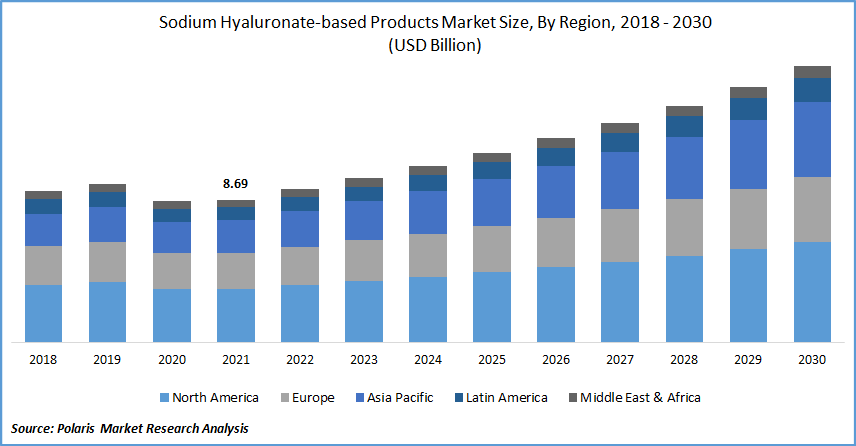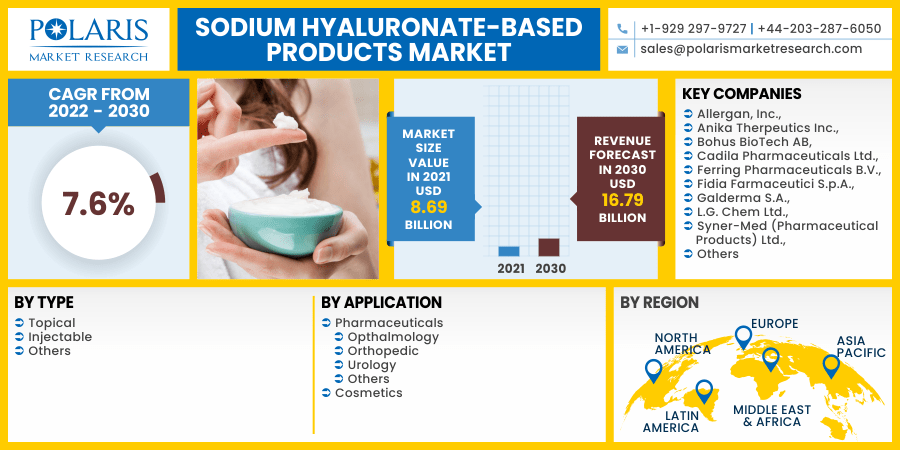
Sodium Hyaluronate-based Products Market Share, Size, Trends, Industry Analysis Report, By Type (Topical, Injectable, Others); By Application (Pharmaceuticals {Opthalmology, Orthopedic, Urology, Others}, Cosmetics); By Region; Segment Forecast, 2022 - 2030
- Published Date:Feb-2022
- Pages: 114
- Format: PDF
- Report ID: PM2261
- Base Year: 2021
- Historical Data: 2018 - 2020
Report Outlook
The global sodium hyaluronate-based products market was valued at USD 8.69 billion in 2021 and is expected to grow at a CAGR of 7.6% during the forecast period. The rising number of non-invasive aesthetic procedures globally and rising consumer awareness for skin-related disease items are driving the industry growth during the forecast period. Newer technology, such as lasers and injectables, are used in minimally invasive procedures to provide treatments that formerly needed major surgeries and recovery times.
 Know more about this report: request for sample pages
Know more about this report: request for sample pages
Cosmetic surgeons have access to various tools and techniques that make minimally invasive procedures like eye lifts and facelifts more cheap and accessible to a wider range of clients. Using injectable cosmetic fillers made of hyaluronic acid, this minimally invasive technique claims to create the look of full, plump lips. The upper and lower lips are augmented, and the outline and curves of the lips are defined. Also, the SARS-CoV-2 pandemic has significantly influenced the hyaluronate-based business. The market demand for sodium hyaluronate-based items has been reduced globally due to a decline in surgical procedures and supply chain problems.
Further, technological advancements and raising awareness for such items boost sodium hyaluronate-based products' market growth. Cosmetic surgeons skilled in laser technology can perform particular minimally invasive operations to heal damaged skin, address pigmentation disorders, and shrink pores. Non-ablative or fractional skin resurfacing is a less invasive procedure that stimulates collagen formation by targeting deeper layers of the skin. Fractional lasers use technology to blend treated and untreated skin patches, keeping the skin more intact and allowing for quicker recovery times.
In both developed and developing countries, phacoemulsification is the most common surgical treatment in ophthalmology. Despite advancements in cataract-extraction technologies, this frequent surgical procedure has been linked to several intraoperative and postoperative problems and side consequences. Permanent corneal decompensation owing to endothelial cell injury is one of the more serious ones. Thus, the factors such as technological advancements, raising awareness of sodium hyaluronate-based products, and minimally invasive treatment have increased the market demand for sodium hyaluronate-based products.
Although sodium hyaluronate-based solutions have numerous advantages, they are sometimes out of reach for certain patient groups due to their high cost. In the U.S., the typical cost of NaHA injections ranges from USD 350 to USD 800. Furthermore, the benefits of product-based dermal fillers are only transitory, lasting for 1.5 years and necessitating routine maintenance procedures to retain the intended effect, resulting in increased costs.

Know more about this report: request for sample pages
Industry Dynamics
Growth Drivers
The sodium hyaluronate-based products market has observed extensive developments in the last few decades supported by variable factors such as the rising geriatric population, which has led to increasing market demand for such products for skin problems. Since skin-related disorders such as wrinkles are relatively high among the geriatric population, the expanding number of older patients is a major driving factor injecting huge growth in the sodium hyaluronate-based products market.
In previous decades, the number of persons aged less than 5 years was higher than those aged 65 or older. The current situation, on the other hand, is rather different. The aging population is expected to expand steadily in the next ten years. According to the World Health Organization (WHO), the number of persons aged 60 and more was around 900 million in 2015. It is anticipated to rise to nearly 2 billion, by 2050, with a larger share expected to come from emerging Asian economies.
Further, antiaging cosmetics and aesthetic therapies, which assist people in reversing their aging indications, are becoming more popular, owing to a global increase in the age population. Sodium hyaluronate-based (NaHA) is more soluble than hyaluronic acid, has smaller molecules, and penetrates deeper into the skin. It's becoming more common in dermal fillers, injected into wrinkled skin parts to help restore a more youthful appearance. RestylaneDefyne, Refyne, and Restylane are a few FDA-approved derived products in the sodium hyaluronate-based products market.
Report Segmentation
The market is primarily segmented based on type, application, and region.
|
By Type |
By Application |
By Region |
|
|
|
Know more about this report: request for sample pages
Insight by Application
Based on the application segment, the pharmaceuticals segment was the most significant revenue contributor in the global sodium hyaluronate-based products market in 2021 and is expected to retain its dominance in the foreseen period. The segment is growing due to its high usage in various pharmaceutical applications. Artificial Tears are used to treat dryness and soreness in the eyes. They make the surface of the person's eye feel more comfortable by moistening, soothing, and lubricating it. Sodium hyaluronate is a component in several distinct types of eye drops. A doctor may prescribe the drops, or the person may purchase them at a pharmacy without a prescription.
Geographic Overview
In terms of geography, North America had the largest revenue share. High healthcare expenditure in countries like the U.S. and Canada, a substantial amount of dermal filler procedures done across the region, a growing geriatric population, technical advances and developments, and so on all contribute to the region's largest market share in the forecast years. For instance, the official estimates of overall healthcare spending in the U.S. are the National Health Expenditure Accounts (NHEA).
In 2019, healthcare expenditure in the U.S. increased by 4.6% to $3.8 trillion, or $11,582 per person. Health care spending represented 17.7% of the country's Gross National Product. According to the United States Census Bureau, 40.3 million Americans aged 65 and up in the 2010 Census and 54.1 million as of July 1, 2019. Thus, the rising geriatric population has led to an increase in skin-related problems and rising healthcare spending, which has increased the market demand for sodium hyaluronate-based products.
Moreover, Asia Pacific is anticipated to witness a high CAGR in the global sodium hyaluronate-based products industry. This is increasing as people become more aware of the benefits of hyaluronan applications. However, the sodium hyaluronate-based products industry expansion is likely to be aided by an increase in the number of cosmetic procedures, increased market demand for medical tourism, and improved healthcare infrastructure in existing countries such as India and China.
Competitive Insight
Some of the major market players operating in the global sodium hyaluronate-based products market include Allergan, Inc., Anika Therpeutics Inc., Bohus BioTech AB, Cadila Pharmaceuticals Ltd., Ferring Pharmaceuticals B.V., Fidia Farmaceutici S.p.A., Galderma S.A., L.G. Chem Ltd., Syner-Med (Pharmaceutical Products) Ltd., among others.
Sodium Hyaluronate-based Products Market Report Scope
|
Report Attributes |
Details |
|
Market size value in 2021 |
USD 8.69 billion |
|
Revenue forecast in 2030 |
USD 16.79 billion |
|
CAGR |
7.6% from 2022 - 2030 |
|
Base year |
2021 |
|
Historical data |
2018 - 2020 |
|
Forecast period |
2022 - 2030 |
|
Quantitative units |
Revenue in USD million/billion and CAGR from 2022 to 2030 |
|
Segments covered |
By Type, By Application, By Region |
|
Regional scope |
North America, Europe, Asia Pacific, Latin America, Middle East & Africa |
|
Key companies |
Allergan, Inc., Anika Therpeutics Inc., Bohus BioTech AB, Cadila Pharmaceuticals Ltd., Ferring Pharmaceuticals B.V., Fidia Farmaceutici S.p.A., Galderma S.A., L.G. Chem Ltd., Syner-Med (Pharmaceutical Products) Ltd., among others. |
